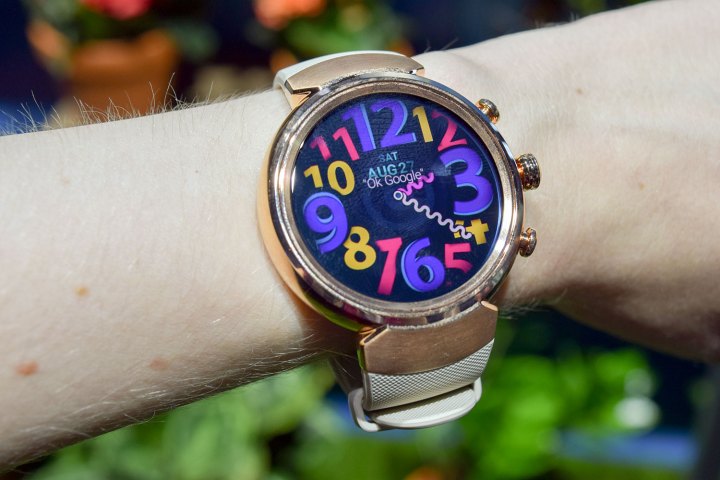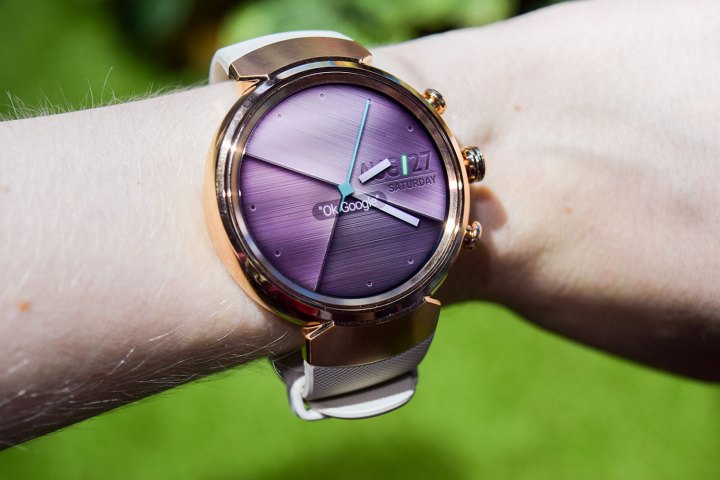Well folks, the day has come. Asus has officially taken the wraps off of the new and highly-anticipated ZenWatch 3, which features a radically different design than its predecessor, the ZenWatch 2.
The new device is powered by the Qualcomm Snapdragon Wear 2100, which is a processor in Qualcomm’s line of chips built specifically for wearable devices. Like Asus’ other smartwatches, it also runs Android Wear, Google’s smartwatch targeted operating system.
We took a look at the device at IFA on Berlin, and here are our initial impressions.
A new, round design
While nearly every other company has moved over to a round smartwatch design, Asus stuck to its curved rectangular design from the first ZenWatch to its second. Finally, with the ZenWatch 3, Asus made its smartwatch round. Although the ZenWatch 2’s rectangular design wasn’t ugly, it did look like a tiny smartphone on your wrist. The new ZenWatch 3 looks much more like a classic watch, with its circular design and choice of either chrome, silver, or black metal for the watch case.
It also has relatively large metal lugs on either side of the watch that connect to the band. These lugs are stiff and set at a very specific angle that’s better suited to large wrists than small ones. On my slender wrist, those lugs ensure that the ZenWatch 3 looks comically large. The watch’s casing isn’t terribly slim, either. The ZenWatch 3 looks best on men’s wrists, though the rose gold version is female friendly — assuming you have the wrists for it.
Asus offers a selection of different straps for the ZenWatch 3, including several leather and silicon options. The smartwatch boasts an IP67 rating, meaning it should be fine getting a few splashes, but you won’t want to submerge it in water for extended periods of time.
The new ZenWatch features a 1.39-inch AMOLED screen with a resolution of 400 x 400 pixels. That display is protected with Corning’s Gorilla Glass, ensuring that even if you drop the watch, the glass won’t shatter. There are also three buttons on the right side of the watch — you can set the top button to go into your favorite applications. The buttons add to the classic watch look, and they make it much easier to access your favorite apps with a single tap.
Android Wear is still a lot of swiping
Since it’s an Android Wear smartwatch, the ZenWatch 3 looks exactly like every other smartwatch that runs Google’s wearable OS. If you’ve seen one Android Wear watch, you’ve seen them all — only design differentiates them. Android Wear 2.0 is still in development, but it brings much-needed improvements in terms of design and ease of use. It’s unknown when the ZenWatch 3 2ill get Android Wear 2.0, but in our opinion, the update can’t come soon enough. The current version of Android Wear looks a bit old fashioned at this point, with its white backgrounds and card-like interface, which is better suited to the square screens of yesteryear.
The main software additions Asus brought to the watch come in the form of a quick-launch app button, and lots of great new watch faces. However, if you really want to personalize your watch, you can check out Asus’ new watch face app on your phone. From there, you can easily search through the many watch faces to find your favorite. Asus also connects you with watch face designing apps, so you can make your own in the event that none of the stock ones appeal to you.
These days, many people buy smartwatches not just to get notifications on their wrist, but also to track their activity. The ZenWatch 3 has some activity-tracking features, which Asus says are 95 percent accurate. You can track all the obvious metrics like steps, mileage, calories burned, and so on.
However, it’s missing some key features that would make it a fitness junkie’s device. For example, while the new ZenWatch can do things like count steps, it doesn’t have a heart rate monitor. It’s an odd omission for a smartwatch in this day and age, especially when you consider that nearly every competitor’s watch offers heart rate tracking.
Battery life expectancy
Asus claims that the ZenWatch 3 boasts advanced power management features, “so it spends more time on the wearers’ wrist and less time charging.” What does that mean in the real world? According to Asus the device will last 1-2 days on a single charge. Asus’ HyperCharge technology also charges the battery up to 60 percent in 15 minutes. That’s a huge win for a smartwatch. After all, nothing is worse than having a dead watch on your wrist that can’t even tell you the time. We’ll have to test Asus’ quick charging claims in our full review.
Asus announced two additional accessories for the watch — a magnetic charger, and a battery pack. You heard that right. The battery pack clips onto the back of the wearable and automatically begins charging — you’ll have to take it off your wrist, though. The company says it gives you up to 40 percent additional battery life.
Pricing and availability
In general, the ZenWatch 3 looks great, but it’s missing a few features that could skyrocket it to fame. It costs 230 euros, which comes out to be around $255. That’s less than many smartwatches, including the Huawei Watch and Apple Watch, both of which start around $350 and go way up from there.
The ZenWatch 3 will arrive in the U.S. and elsewhere in October. Currently, we don’t know the exact date, but we’ll keep you posted here.
Stay tuned for more IFA 2016 news and our full review.
Highs
- New round design is an improvement
- App launch button is useful
- $255 is a reasonable price
Lows
- Large lugs make it too big for small wrists
- No heart rate sensor
Article originally published in July 2016 by Andy Boxall. Christian de Looper also contributed to this report.


